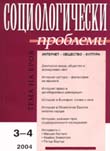Халите в модерната топология на София: символни и социално-политически проекции
The Market Hall in the Topology of Sofia: Symbolic and Social – Political Projections
Author(s): Elitsa StanoevaSubject(s): Social Sciences
Published by: Институт по философия и социология при БАН
Summary/Abstract: This paper is an attempt at a sociological analysis of one isolated element in the topology of Sofia after the Liberation in 1878. In the construction of this distinct element, however, more general processes are being revealed: the formation of an urban physiognomy that is adequate for an European capital city of a nation-state as well as the counter process – the de-formation of the established oriental image of the city; urban modernization and overcoming of the inherited traditional urban structure. More or less those processes reflected the ideology of state policy, the mentality patterns of urban population and in turn, they determined the town-planning strategy, social changes, institutionalized practices and normalized behavioral standards. At an unsteady pace they penetrated into the entire space of Sofia. The construction pro-ject for a Municipal Covered Marketplace, po-pularly known as Khalite (Les Halles), was not a central component of the transformation that was affecting the city as a designed space and as an inhabited space. Nevertheless, placed in the wider context of modernizing the market, constituting the symbolic appearance of the capital in accordance with the new political status of the country, and shaping a new national identity of Bulgarian populace, this project illustrates the latter processes. In that sense the building of Khalite is a focal example of all the structural changes in both the physical environment and the social fabric of Sofia that were going on around the turn of the 20th century.
Journal: Социологически проблеми
- Issue Year: 36/2004
- Issue No: 3-4
- Page Range: 289-306
- Page Count: 18
- Language: Bulgarian
- Content File-PDF

